Results
-
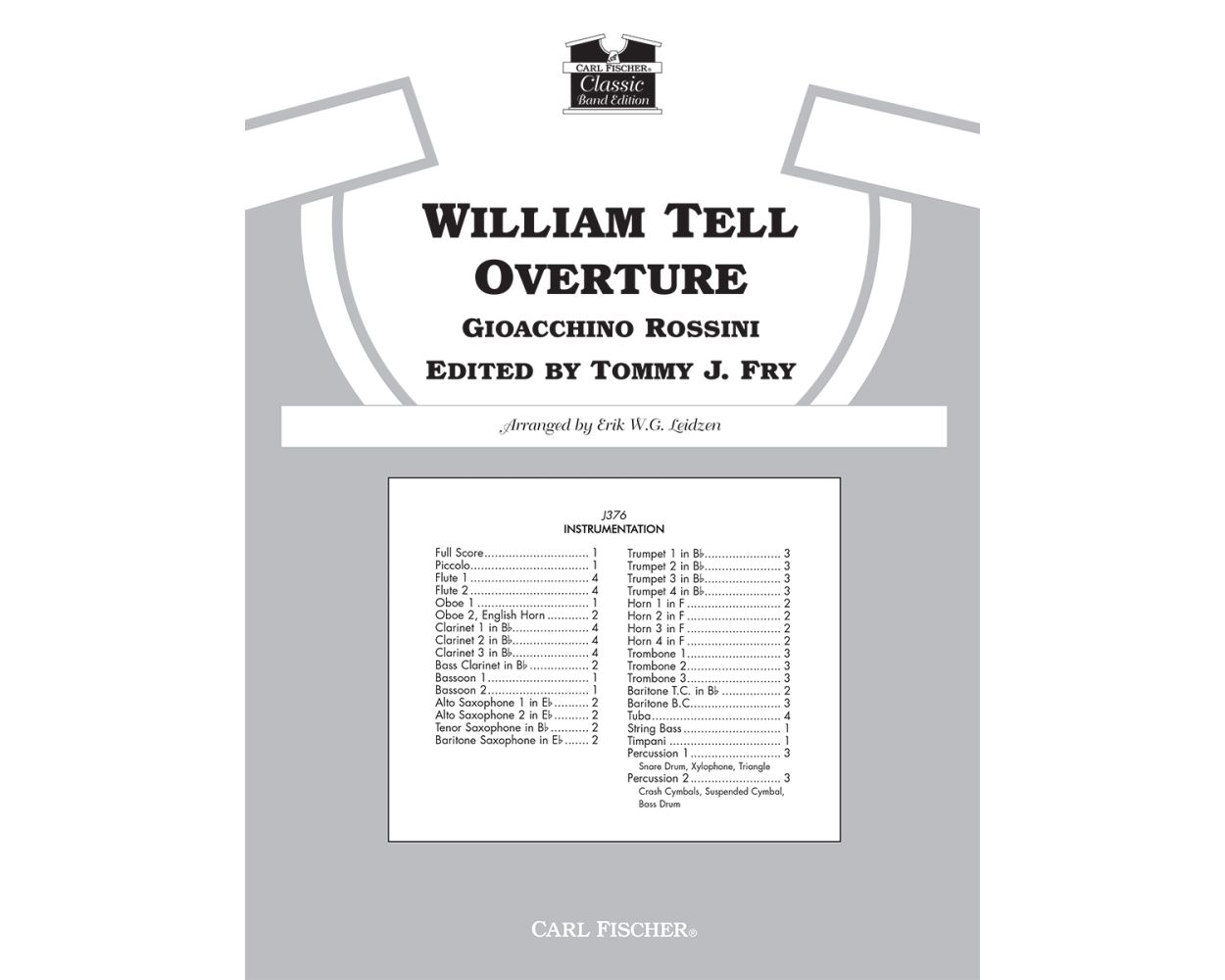 £170.00
£170.00William Tell Overture - Gioachino Rossini
One of the great, classic transcriptions of the concert band repertoire, Leidzen's famous arrangement of the most popular and beloved of Rossini's opera overtures has been reissued in a fine modern edition edited by Tommy J. Fry. From the atmospheric opening, through the brilliant storm sequence and following pastorale (with its English horn solo), to the quick march, almost inseparable, for Americans of a certain age, from The Lone Ranger, this is a dazzling survey of what a talented modern band should be able to achieve.
Estimated dispatch 12-14 working days
-
 £49.00
£49.00Joust
You will hear the power and aggressive nature of the medieval tournament in this strong new work for developing bands by Larry Clark. Larry's pieces are some of the most performed at this grade level and this piece proves why with its bold rhythms, powerful harmonies and singable melodies. Every section of the band gets to shine in this contest/festival style piece.
Estimated dispatch 12-14 working days
-
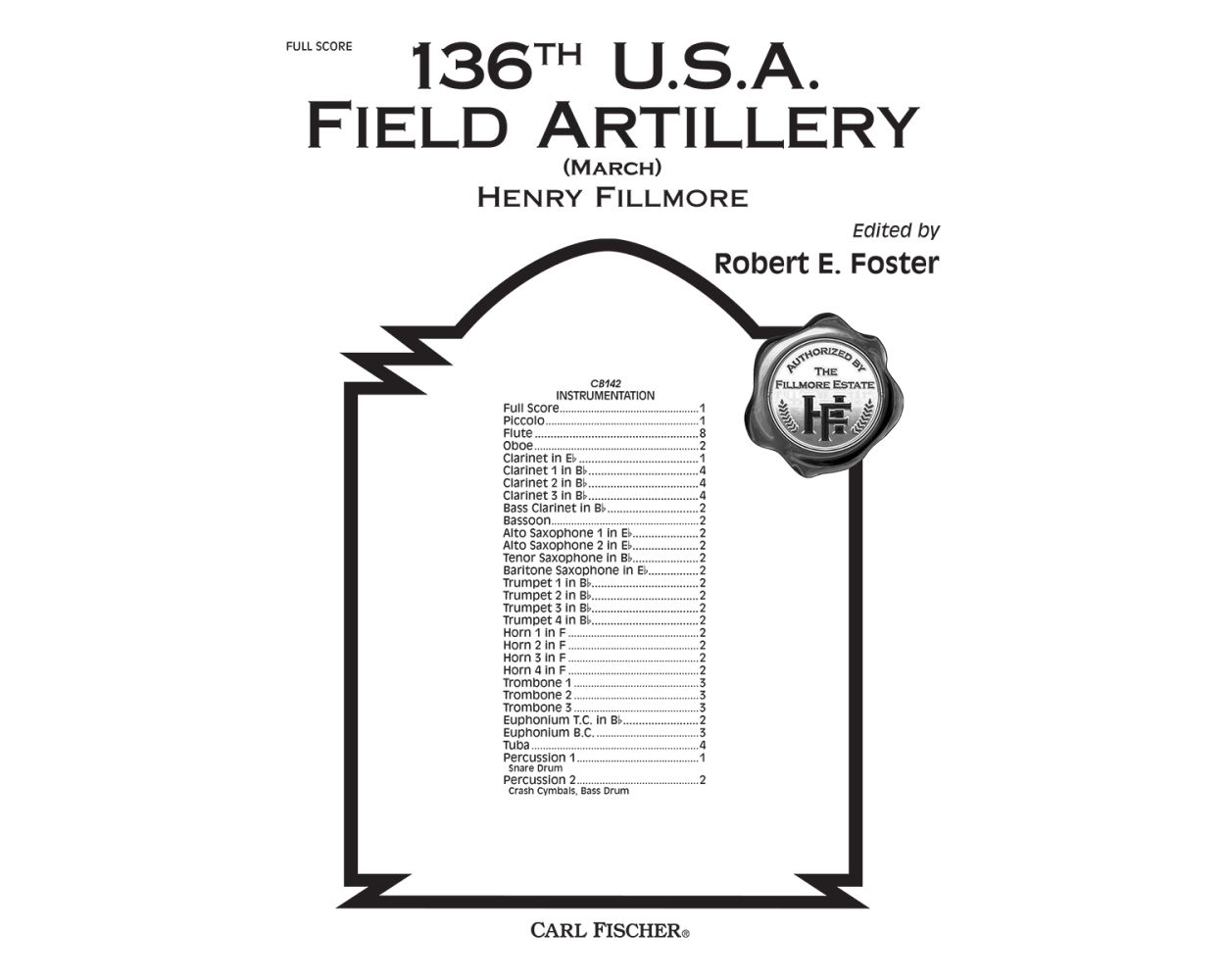 £76.00
£76.00136th U.S.A. Field Artillery - Henry Fillmore
Editor Robert Foster has uncovered another forgotten Henry Fillmore march and restored it to its rightful place in band repertoire. This may be one of the best Fillmore marches we have heard that is for the most part still unknown. Written to stir patriotism during World War I, all of the wonderful Fillmore trademarks are present in this exceptional march. It is tuneful, exciting and well-scored; presented in a full score edition for the first time, exactly as Fillmore intended it to be.
Estimated dispatch 12-14 working days
-
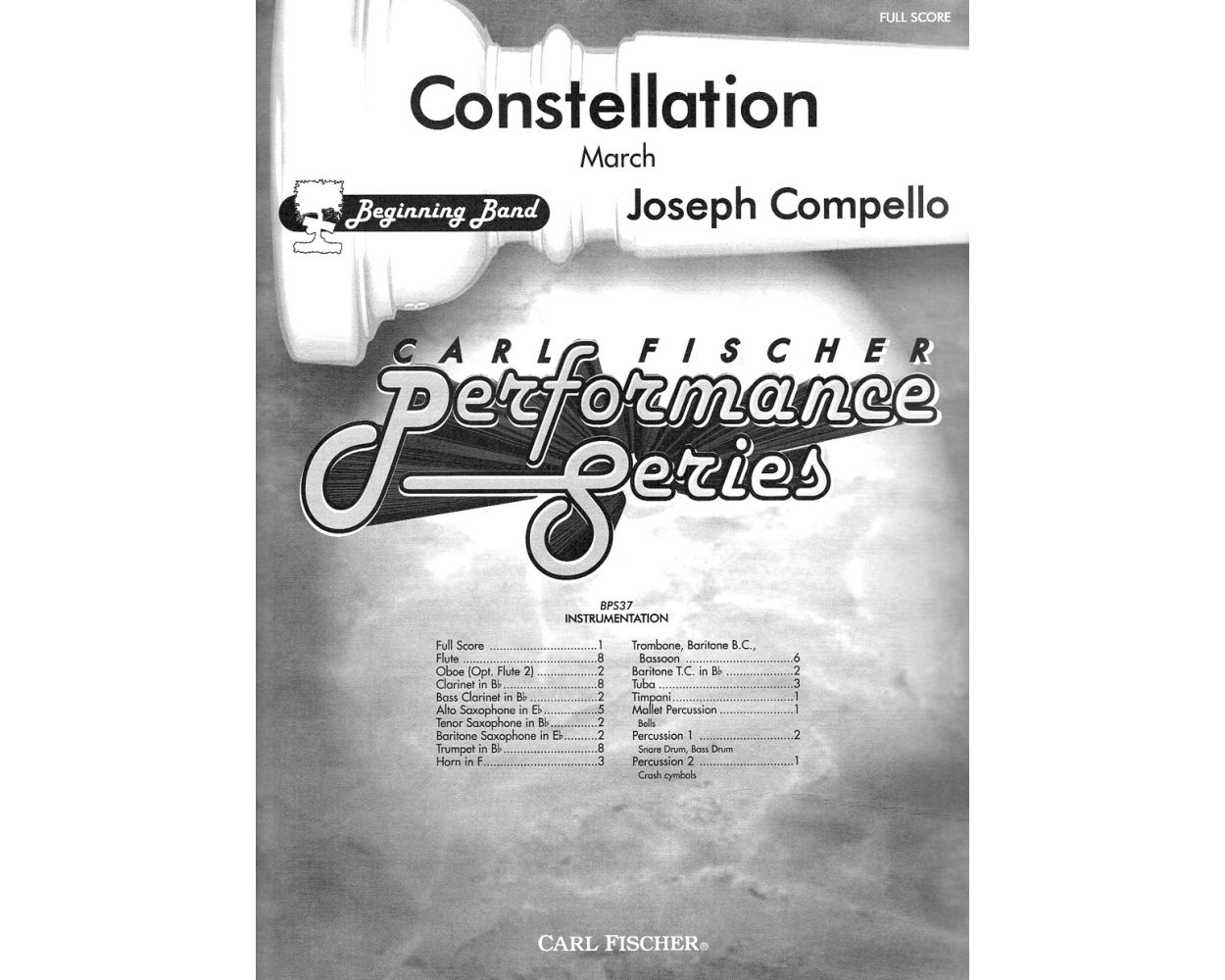 £40.00
£40.00Constellation
Introduce the march form to your students with the simplest of marches. This piece features bold trumpet fanfare figures, where quarter notes are the most difficult rhythms to play. In addition, the tune only uses the first 6 notes of the Bb scale (Bb through G) as its range.
Estimated dispatch 12-14 working days
-
 £113.30
£113.30Moderate Dances - Angelo Sormani
This piece is a tribute to dance music, especially passionate, intense and meditative dance music. "Moderate Dances" is divided into three movements: a "Tango", a "Slow Waltz" and a "Bossa Nova". Each movement and each dance has its own particular characteristics but, when combined, these different rhythmic beats and times give the piece a feeling of completeness and uniformity. The Tango started to flourish in the suburbs of Buenos Aires in around 1880. There is still some doubt as to its origins, which may be Cuban (Habanera) but are probably African. It was most popular in Argentina and Brazil: here the male protagonist was originally the "gaucho" with his inseparable guitar, later to be replaced by the proud, elegant "compadre". By around 1910 the Tango had spread to Italy and France. New clubs opened, where the upper classes could watch and dance the Tango. Here the dance also underwent some rapid transformations. The exaggerated and extravagant gestures and body movements disappeared. Slow, gliding steps replaced the old rotational movements. The women's red ankle-boots and the partners "staring into each other's eyes" accentuated the erotic nature and sensuality of this dance. So much so that, in 1913, the German government banned soldiers from dancing the Tango. Those who broke the law were immediately discharged from the army. From a strictly musical perspective, the basic instruments were a flute, a harp (the diatonic harp typically played by the Indians of Paraguay) and a violin, or flute, guitar and violin or even clarinet, guitar and violin. These instruments were easy to transport, ideal for playing at parties, in the streets and in courtyards. The musicians played by ear, frequently improvising: there were no scores, no records, which is the main reason why it is impossible to trace the Tango back to its exact origins. However, the Tango's evolution (and growing popularity) was once again fostered by its fundamental ability to absorb "other" cultures, languages and sounds. And it was the arrival of the "bandoneon" (an accordion-like instrument that was invented in Germany and brought to Rio de la Plata by some immigrant), which replaced the flute, that marked the beginning of the Tango's huge success outside Argentina. A number of talented composers, above all the great Astor Piazzola (1921-1992), transformed the bandoneon from a simple accompanying instrument to a solo instrument that was to become the distinguishing feature of the 20th century Tango. The Slow Waltz originated from the Waltz, the typical dance of the Bavarian and Tyrolese peasants in the 1700s. It was composers like Johann Strauss, father and son, who carried the Waltz to its zenith in the 1800s, creating the sensual and melancholy yet joyful and charming dance we are all familiar with. When the Waltz first became popular in Germany, the members of respectable society were shocked at the closeness of the dancing partners, who had always previously danced apart. The main difference between the Waltz and Slow Waltz is that the latter has a slower, more expressive rhythm: the men wear tails and the women wear ball gowns decorated with beads and feathers and couples dance in graceful rotational movements. "Bossa Nova" is the title of the last movement in the piece. Jobim, the great Brazilian musician, described this musical genre as a combination of modern Jazz and Samba. Bossa Nova means "new wave". This was the name of the artistic and musical movement that evolved in Brazil in the late Fifties and was extremely popular throughout the Sixties. The songs are usually about love or social matters, drawing inspiration from the slums of Rio De Janeiro and the lives of their inhabitants. Bossa Nova, with its original compositions and the artistic talent of its musicians, also became hugely popular in the United States and Europe, and top Jazz musicians (Ella Fitzgerald, Stan Getz, Bob Cooper, Charlie Bird, Sonny Rollins, Dexter Gordon, Dizzy Gillespie) started to include Bossa in their repertoires.
Estimated dispatch 7-14 working days
-
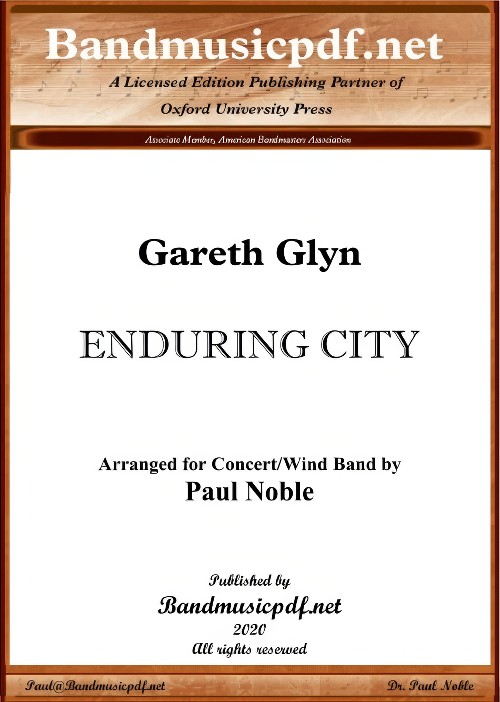 £295.00
£295.00Enduring City (Concert Band - Score and Parts) - Glyn, Gareth - Noble, Paul
Enduring City was composed to celebrate the 300th anniversary of the founding of New Bern, the first permanent seat of the colonial government of the state of North Carolina. It was first settled in 1710 by Swiss and German immigrants under the leadership of Christoph von Graffenried and and John Lawson. The 2010 composition was commissioned by the New Bern 300th Anniversary Committee and the City of New Bern, to portray the city in terms of its history, its present and its optimism for the future; the North Carolina Symphony gave its first performances, in venues throughout the state. Its one continuous movement is in well-defined sections. Most of the musical themes derive from names of people and places connected with New Bern, using letters that are also note-names, omitting those which are not. For example, the opening trumpets spell out E-B-E-D for New Bern ('R' standing for Re, which is D in fixed-doh sol-fa notation) and B-C-G for Baron Christoph von Graffenried. They are answered by the orchestra's "John Lawson, Gent.", the name on the cover of the co-founder's A New Voyage to Carolina. Lawson's questing and adventurous character is then suggested, accompanied by a "Carolina" note-name theme; and, after the Graffenried theme on solo horn, the music of both men combines for their voyage, culminating (on trumpets and trombones) in the founding of New Bern. The story of Tryon Palace, central to the city's history, is represented by echoes of the various kinds of music heard at the Governor's residence - fife and drum bands, minuets and the slaves' "Jonkonnu" festivals from Africa, celebratory fanfares and fireworks; the section reaches a climactic ending when all are combined. After a peremptory interruption by the snare drum, the perky fife theme is transformed to portray the conflicts that visited New Bern over the centuries, alternating with a new "grief" theme, which - when sounded by strings alone - leads to music of reconciliation and then of the natural beauty of the city's surroundings. A steady, lively rhythm underpins the final section, confidence - in the present and for the future. Echoes of previous themes are heard, but the closing peroration is reserved for a majestic and joyous statement of the name of New Bern itself.
Estimated dispatch 7-14 working days
-
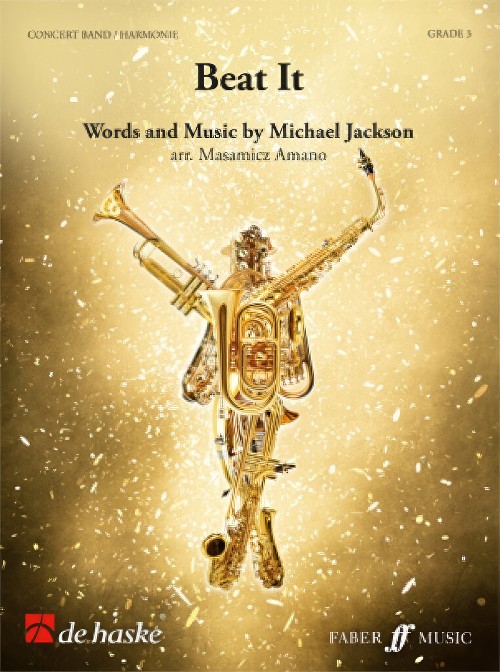 £94.99
£94.99Beat it (Concert Band - Score and Parts) - Jackson, Michael - Amano, Masamicz
Beat It, is one of Michael Jackson's most popular songs, awarded two Grammys for its commercial success. Seen by many as a rock song, Beat It was ranked by Rolling Stone magazine as one of the "100 Greatest Guitar Songs of All Time." Since its release, the song has been covered and famously reinterpreted by artists such as Fall Out Boy, Fergie and most recently Masamicz Amano, who has made this wonderful arrangement for concert band!Duration: 4:15
Estimated dispatch 7-14 working days
-
 £59.40
£59.40Sheep May Safely Graze - Bach, Johann Sebastian
Probably Bach's most pastoral composition. Despite its original appearance as part of a virile hunting cantata, this gentle aria remains one of the composer's most beloved and most frequently performed works.
Estimated dispatch 7-14 working days
-
 £115.60
£115.60Romjulsdrm - Thoralf Borg
The poem Romjulsdrm ("Christmas Dream") was first published in Arbeiderbladet on January 3rd 1959, and became known when Thoralf Borg set a melody to it in 1968. Up until this, Alf Prysen had used a melody quite similar to the song Lijan uti dalen, when he sang the song in the TV program Ei vise vil jeg synge in 1964. At the same time that Borg's melody was written, the last four lines of text were also added to the poem, and the song took on the form we know today.The form and structure of this arrangement originates from a version for big band and vocals commissioned by stre Toten Storband, written in 2018 for one of their traditional midnight concerts on the day before Christmas. In an attempt to give the arrangement a nice calm and the text a lot of room, as is often the case in songs like this, it ended up in a relatively narrative style where the variation in tempo and the shifts between swing and straight eighth notes are particularly central.The song is about family, friendship and the quiet days of the Christmas holidays, which hopefully is something most people can recognise. The arrangement for the aforementioned midnight concert was ordered because my sister was to be the soloist for the concert, and since my father also played lead trombone - as he has done in this big band for as long as I can remember - it was natural to add a small trombone solo as well. It's always special to write and arrange music for people I know and appreciate, but it's extra special when it's also for two of my great role models.- David Stre Hveem -
Estimated dispatch 7-14 working days
-
 £164.50
£164.50Pacific Heights - Gorham
Pacific Heights draws its title from the famous historic San Francisco neighborhood of the same name. Established in the late 1800's this area of the city embodies Hollywood's vision of San Francisco with its views of the Bay and the Golden Gate Bridge. While the music is not intended to be programmatic, it captures some of the great sites of the city: the majestic Golden Gate Bridge, the rocky island which is home to our country's most infamous prison, as well as the many moods of this city known for its diversity, flower-power, steep rolling hills, earthquakes, and chilly winds off the ocean.
Estimated dispatch 7-14 working days
